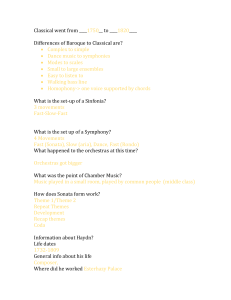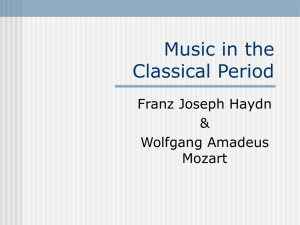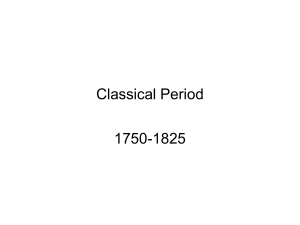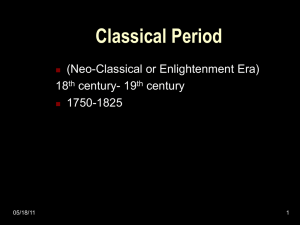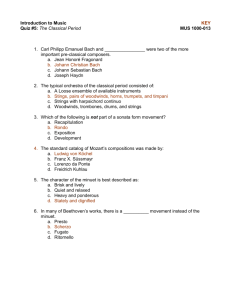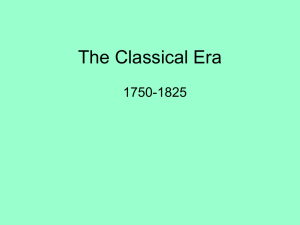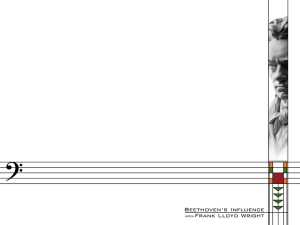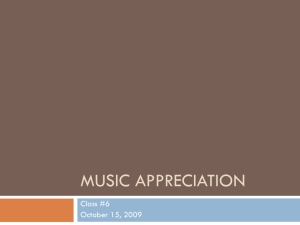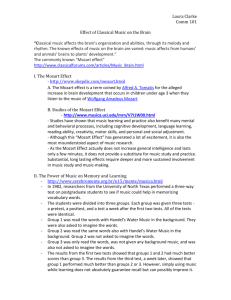Music History Classical Music – The Classical Era Lecture Notes
advertisement
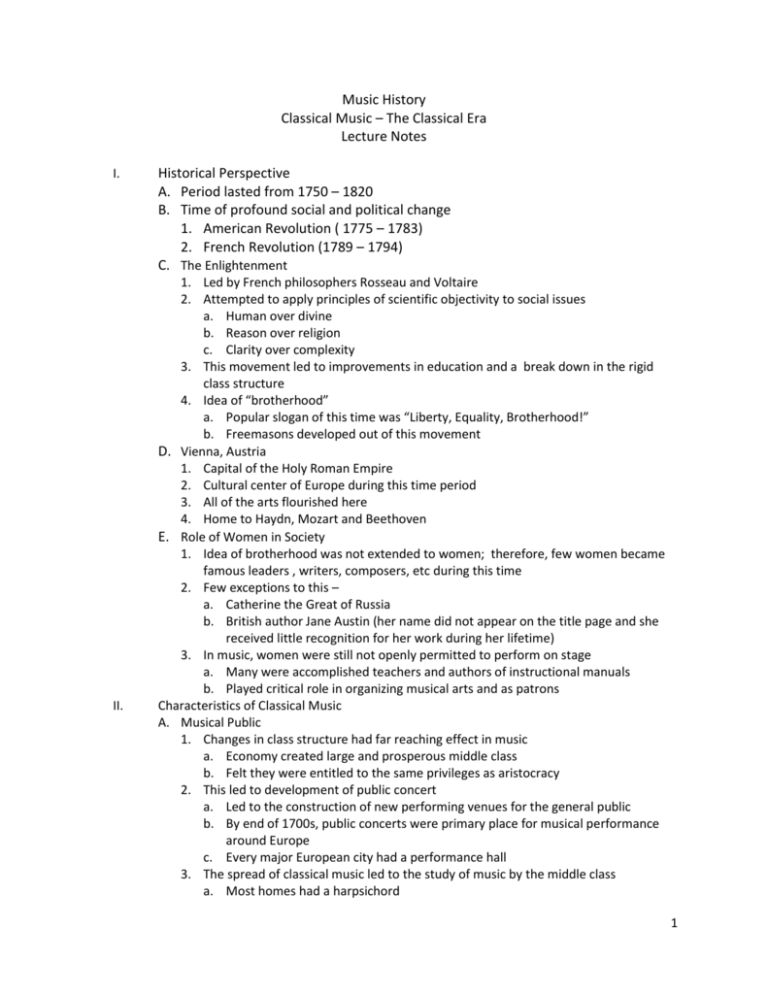
Music History Classical Music – The Classical Era Lecture Notes I. II. Historical Perspective A. Period lasted from 1750 – 1820 B. Time of profound social and political change 1. American Revolution ( 1775 – 1783) 2. French Revolution (1789 – 1794) C. The Enlightenment 1. Led by French philosophers Rosseau and Voltaire 2. Attempted to apply principles of scientific objectivity to social issues a. Human over divine b. Reason over religion c. Clarity over complexity 3. This movement led to improvements in education and a break down in the rigid class structure 4. Idea of “brotherhood” a. Popular slogan of this time was “Liberty, Equality, Brotherhood!” b. Freemasons developed out of this movement D. Vienna, Austria 1. Capital of the Holy Roman Empire 2. Cultural center of Europe during this time period 3. All of the arts flourished here 4. Home to Haydn, Mozart and Beethoven E. Role of Women in Society 1. Idea of brotherhood was not extended to women; therefore, few women became famous leaders , writers, composers, etc during this time 2. Few exceptions to this – a. Catherine the Great of Russia b. British author Jane Austin (her name did not appear on the title page and she received little recognition for her work during her lifetime) 3. In music, women were still not openly permitted to perform on stage a. Many were accomplished teachers and authors of instructional manuals b. Played critical role in organizing musical arts and as patrons Characteristics of Classical Music A. Musical Public 1. Changes in class structure had far reaching effect in music a. Economy created large and prosperous middle class b. Felt they were entitled to the same privileges as aristocracy 2. This led to development of public concert a. Led to the construction of new performing venues for the general public b. By end of 1700s, public concerts were primary place for musical performance around Europe c. Every major European city had a performance hall 3. The spread of classical music led to the study of music by the middle class a. Most homes had a harpsichord 1 b. Because music publishing continued to grow, music was readily available for all B. Professional Musicians and Composers 1. Many were still supported by the nobility and the church 2. By the end of the classical era, they were making a living on their own terms a. Commission – a piece of music that is paid for by a person for a specific person (Ex. I am commissioning a piece to be written for a wedding) b. This led to more independence for musicians C. Opera 1. Continues to develop from the Baroque period 2. By the end of the Baroque, there was some criticism of opera a. Plots were always about mythology or history – people found this hard to relate to, unrealistic b. Stage sets and machinery were too involved – many times they malfunctioned, frequently causing damage to the theatre c. Because opera was always in Italian, it was impossible to understand 3. The changes in opera aligned with the changes in society a. Baroque opera was viewed as being for the aristocracy b. Classical opera was for everyone; stories became about real people in everyday situations in their native language 4. The result of these changes was the beginning of comic opera a. Featured simple music, down to earth characters and an amusing plot b. Included some spoken dialogue instead of being all sung c. La Serva Padrona (1733) “The Servant Girl who Became the Mistress” i. One of the first comic operas ii. Plot designed to appeal to age when rigid class structure was being questioned D. Oratorios 1. These works continue to be composed and performed in much the same way as they were in the Baroque era 2. Few changes to this form E. Sacred Music 1. Forms from the Baroque era continue on into the Classical period 2. Requiem Mass – Mass for the dead – becomes common F. Symphony 1. Developed during this time period and were mastered by Haydn and Mozart 2. Origins date back to 1730 3. Began as an introductory piece to opera a. All Italian operas were preceded by an instrumental piece of music that introduced audience to the melodies from the work at the beginning of the performance b. Name for this was sinfonia – Italian word meaning “symphony” c. Gradually, these pieces gained independence and were performed apart from opera d. This lead to the idea of independent instrumental works of music on a larger scale 4. Mannheim, Germany and Johann Stamitz a. This was the part of Europe that was the leader in developing the symphony as a new form of music 2 III. b. Johann Stamitz (1717 – 1757) was the composer at the court in Stamitz i. He was a prolific composer, writing over 60 symphonies ii. He established the form of the symphony and the structure of the orchestra c. Form i. Expanded fast – slow – fast – slow, three movement form into four movements ii. Movement 1: fast and serious Movement 2: slow and lyrical Movement 3: graceful, moderate tempo (usually a dance form, like a waltz) Movement 4: very fast and lively d. Structure of classical orchestra i. Complete string section – violin, viola, cello, bass ii. Pairs of woodwind and brass instruments – 2 flutes, 2 oboes, 2 bassoons, 2 horns iii. Limited percussion – timpani and cymbals iv. By the end of the classical era, the orchestra would grow to include clarinets, trumpets and trombones G. Chamber Music 1. The increase of middle class musicians led to a new venue for musical performances a. These performances generally took place in people’s private homes. b. The word “chamber” refers to a house’s living room 2. Pieces were designed to be played by a small ensemble in a small space for a small audience 3. Most middle class homes had a keyboard instrument a. Until about 1775, this was a harpsichord b. Pianos became widely available and gradually replaced the harpsichord 4. Music performed in this way included the sonata, as well as duets and trios for a variety of instruments 5. Led to the development of string quartet H. String Quartet 1. Pieces written in this format began to appear around 1750 2. Ensemble is made up of 4 string instruments – 2 violins, 1 viola and 1 cello – instrumentation is always the same 3. This was an extremely popular ensemble during this time 4. Music composed for this group closely followed the form of a symphony a. 4 movements long b. Movement 1: fast and serious Movement 2: slow and lyrical Movement 3: graceful, moderate tempo (usually a dance form, like a waltz) Movement 4: very fast and lively c. Word ‘string quartet’ refers to both the ensemble (2 violins, viola and cello) and the form of the piece Composers of the Classical Era A. Franz Joseph Haydn 1. 1732 – 1809 2. Born in a small village in Austria 3 3. Father was a wheel maker – an important job in the 18th century 4. One of 12 children 5. At age 8, Haydn was accepted as a choir boy at St. Stephen’s cathedral in Vienna – very prominent position a. He remained in this position until his voice changed at the age of 18 b. At the cathedral, he learned to play harpsichord and violin 6. After he completed his time at the cathedral, he made a living in Vienna teaching music lessons to the wealthy; he lived in an apartment building during this time a. Some very influential people also lived in this building b. Pietro Metastasio – famous opera librettist at this time, many contacts within musical circles c. Maria Esterhazy – daughter of wealthy aristocracy 7. In 1761, Haydn was hired as an assistant music director to Prince Paul Esterhazy a. The prince had a small orchestra of about 12 players b. Haydn was responsible for composing, supervising and rehearsing musicians as well as caring for the instruments 8. In 1762, Prince Paul dies and Prince Nikolaus Esterhazy takes over a. He was an avid lover of music and spent lots of money on it in his court b. He built a large palace in the countryside with 2 large music rooms for performance and 2 small theaters for opera 9. In 1766, Haydn was promoted to music director (Kapellmeister) a. Became responsible for all music within the Esterhazy estates b. Usually performed two large concerts each week c. Extra concerts were performed whenever there were guests d. Music was performed during meals and the prince had chamber music performed in his private rooms almost every day 10. As a member of the staff in the Esterhazy court, Haydn was required to dress formally and was treated in the same way as a servant a. Slept in the servants quarters of the estates b. Was forbidden to give away or sell any music without the knowledge and permission of the prince 11. Haydn stayed in the service of the Esterhazy family until the death of Prince Nikolaus in 1790 a. The Esterhazy family was then taken over by Nikolaus II b. He was not an advocate of music and disbanded the orchestra 12. Haydn was nearly 60, so he moved back to Vienna a. By this time he had earned an international reputation b. His music was published (mostly illegally) all over Europe 13. Haydn was extremely popular in London a. Traveled to London twice after leaving the Esterhazy family b. Awarded honorary degrees c. Was treated as a celebrity d. Completed his last 12 symphonies in London – called the London Symphonies 14. Haydn lived out his life in Vienna a. Continued composing until the end of his life b. Composed some of his greatest works, including two oratorios – The Creation and The Seasons 15. Haydn died in 1809 at the age of 77 4 a. His reputation transcended national disputes b. At the time of his death, Vienna was under attack from France c. Napoleon had a guard posted at Haydn’s door to care for him and protect him 16. Haydn’s music a. One of the most prolific composers in all of music history b. 17 operas c. 3 oratorios d. 15 masses e. 77 string quartets f. 108 symphonies g. Over 50 keyboard sonatas h. Numerous works for choir i. Large amount of various chamber pieces for a variety of instruments j. Haydn composed in every classical form of the day k. Showed his personality (especially sense of humor) through his music B. Wolfgang Amadeus Mozart 1. One of the most studied figures in all of music history 2. 1756 – 1759 3. Born in Salzburg, Austria 4. Born into a musical family a. Sister, Maria Anna (Nanneral) was also considered to be a child prodigy b. Father, Leopold, was a distinguished performer, composer, author, and theorist; he wrote a book on violin playing and performance practice 5. By the age of 4, Mozart displayed considerable musical ability 6. At age 6, he was composing and performing on the harpsichord in public; his earliest composition dates from age 5 7. For the next 10 years, Leopold took Mozart all over Europe to perform in courts and towns for noblemen and princes 8. Mozart was frequently “tested” a. Asked to sight read difficult music b. Asked to improvise a melody c. Asked to play the harpsichord backwards d. Examined by a doctor to be sure that he wasn’t a midget 9. These travels exposed him to numerous musical influences a. Could write down any piece that he heard b. Heard music by all the great composers of the day c. From all of these sources, Mozart created his own unique musical identity 10. By age 10, Mozart had composed his first full symphony 11. At age 14, he produced his first full length opera 12. During his youth, Leopold was Mozart’s only teacher and constant companion on his travels 13. By the age of 17, he was widely considered to be a mature artist – began to look for a job a. Traveled all over Europe to look for work b. At this time, he traveled with his mother c. While in Paris, she passed away; this was very traumatic for Mozart 14. No one would offer Mozart a permanent position 5 15. 16. 17. 18. 19. 20. 21. 22. 23. 24. a. Courts felt that he was too young and too talented – overqualified – for their positions b. Very temperamental Mozart returned to Salzburg without finding any employment and receives a temporary position with the Archbishop as he traveled to Vienna a. On this trip, he is expected to dress like a servant and sleep in the servant’s quarters b. While in Vienna, Mozart is invited to perform at the homes of various aristocrats; however the archbishop refuses to let him leave c. At this time, Mozart demanded release from his employment Mozart is at a critical point in his life a. He decides that he does not want to be in the employment of an individual or the church and have them dictate to him what and how he composes music b. He becomes a freelance musician – he chooses what he wants to do and how he wants to do it, taking commissions to make a living At first, Mozart supplements this income by teaching piano lessons; gradually he begins to earn a good living with his compositions Early works a. Some commissions, including numerous piano sonatas for various students b. He found great success with his German comic opera The Abduction from the Seraglio (1782) – story of a brothel, lead character is named after his future wife In 1782, Mozart marries the daughter of his landlady – Costanze Weber – against the wishes of his father a. The two remain married until Mozart’s death b. Together they have 6 children, only 2 survived past infancy and neither of them ever had any children Following his marriage is a period of great success a. Composed a series of string quartets that were in the style of Haydn and dedicated to him (the two composers met in life several times) b. Earned great fame and fortune with is piano concertos – composed 12 of them between 1784 and 1786 and usually performed the pieces himself In the late 1786 to early 1788, Mozart’s popularity faded and he faced a financial crisis a. Vienna was in recession – less money for the arts b. Commissions were hard to come by c. Secured loans from many friends d. Even attempted to secure a position with a court e. During this time, he composed little By 1789, Mozart was on the rebound, although financial worries persisted In 1791, Mozart became ill a. Illness began in September b. By late November, he was bedridden c. Died at 1:00 a.m. on December 5, 1791 at the age of 35 d. Unclear what he died from, although most generally agree that it was most likely rheumatic fever When Mozart died, he left many debts for his wife and children a. Costanze became a skilled business woman, organizing memorial concerts for her husband and working to publish his works 6 b. She also sold off numerous works in order to make ends meet c. She eventually remarried and published a biography of Mozart 25. Mozart’s music a. His music appealed to many people because of its simple sophistication b. Everything is a melody c. Composed more than 800 compositions in his 35 years d. Wrote in all the genres of the classical era e. 16 operas, including The Marriage of Figaro (1786), Don Giovanni (1787), The Magic Flute (1791) f. 41 symphonies g. 6 Masses h. 3 oratorios i. More than 30 sonatas for the violin and keyboard j. Concertos for flute (2), oboe, Clarinet, bassoon, horn (4), violin (5) and piano (27) k. Composed numerous string quartets, including Eine Kleine Nachtmusik l. Composed numerous wind serenades for various combinations of wind instruments 26. Cataloguing Mozart’s music a. a Köchel catalogue number is used to identify Mozart’s works and the order in which they were composed b. The first edition of the catalogue was completed in 1862 by Ludwig von Köchel c. It has since been repeatedly updated, as scholarly research improves our knowledge of the dates and authenticity of individual works d. This is a unique number assigned, in regular chronological order, to every one of his known works e. A work is referenced by the abbreviation "K." followed by this number (ex. K. 542a) 7
